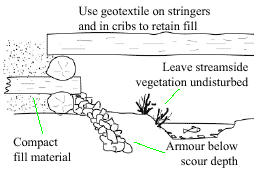| Forest Road Drainage Installation Practices | |
| in the Pacific Northwest | |
| 13 - Erosion Protection | Stream Culverts, Cross Drains, Bridges |
Intakes may be placed slightly above the stream bottom to create the effect of a catch basin. If there is a risk of erosion at the intake, place armour so that it is flush with the intake when the installation is complete. Otherwise, if some of the flow can bypass the culvert intake, back eddying may prevent an unobstructed water flow through the culvert. Install proper ditch blocks. Always protect culvert outlets by rock. If there is a risk of channel down-cutting from outlet fall, place armour below outlet and some distance downstream.
Pipe culverts in fish-bearing streams must be embedded in the stream channel to ensure fish passage. Armour protection must prevent erosion of fill and streambed material from around intakes and outlets. Pay particular attention to the depth and slope of the pipe to avoid the development of a plunge pool. Ensure that bedding material around the pipe receives proper compaction during the installation.
| Figure 3: Armour Below Scour Depth |

|
It should be angular and well graded, and 50% should be 10% bigger than the biggest rocks moved by peak flows. Place armour below scour depth and force it into the soil with the excavator bucket. Simply "sprinkling" rock around intake and outlet is very ineffective and expensive. Avoid using round river rock as armour if possible.
(Ditch Culverts) Cross drains are an important component of drainage system maintenance and ditch management. They drain ditch water accumulations from seepages and surface runoff to the low side of the road prism. To prevent erosion, armour culvert outflows from outlet to natural stable forest floor. If cross drains are protruding from the fill, place rock or other energy dissipators below the outfall for low water levels and for peak flows. Cross drains are important for diverting sedimentladen ditch water onto vegetated slopes away from streams.
The base of these structures should be placed below the scour depth to reduce the risk of erosion. Armour as in pipe culverts above. If site conditions do not allow the placement of footings below the scour depth, armour must protect the substructure (log cribs, pre-cast footings or lock blocks) without encroaching on the stream, or pinching the flow. Armour must be placed well below the scour depth of the stream.
End fills and bedding materials should always be coarse grained. If fine-textured soils must be used in approach fills, cover the fill with geotextiles before placing the erosion protection. The geotextile layer will prevent the erosion of even small soil particles from underneath the armour. Ensure proper fill slopes and material compaction.
Use geotextile on stringers and in cribs to retain fill Compact fill material Armour below scour depth Figure 3: Armour Below Scour Depth Leave streamside vegetation undisturbed
| 13 - Erosion Protection |
| Next |
||
| PLANNING ISSUES |
INSTALLATION PRACTICES
|
|
©1999 - 2001 Flip Productions Limited Used with permission by CulvertBC |